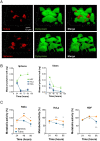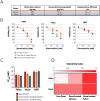Tuning cell behavior with nanoparticle shape
- PMID: 33186380
- PMCID: PMC7665645
- DOI: 10.1371/journal.pone.0240197
Tuning cell behavior with nanoparticle shape
Abstract
We investigated how the shape of polymeric vesicles, made by the exact same material, impacts the replication activity and metabolic state of both cancer and non-cancer cell types. First, we isolated discrete geometrical structures (spheres and tubes) from a heterogeneous sample using density-gradient centrifugation. Then, we characterized the cellular internalization and the kinetics of uptake of both types of polymersomes in different cell types (either cancer or non-cancer cells). We also investigated the cellular metabolic response as a function of the shape of the structures internalized and discovered that tubular vesicles induce a significant decrease in the replication activity of cancer cells compared to spherical vesicles. We related this effect to the significant up-regulation of the tumor suppressor genes p21 and p53 with a concomitant activation of caspase 3/7. Finally, we demonstrated that combining the intrinsic shape-dependent effects of tubes with the delivery of doxorubicin significantly increases the cytotoxicity of the system. Our results illustrate how the geometrical conformation of nanoparticles could impact cell behavior and how this could be tuned to create novel drug delivery systems tailored to specific biomedical application.
Conflict of interest statement
We acknowledge Astrazeneca for covering part of the S.C.D.S. salary. We also thank British Technology Group (BTG) for donating the MPC monomer. There are no patents, products in development or marketed products to declare. This does not alter our adherence to PLOS ONE policies on sharing data and materials.
Figures





References
Publication types
MeSH terms
Substances
Associated data
LinkOut - more resources
Full Text Sources
Medical
Research Materials
Miscellaneous

